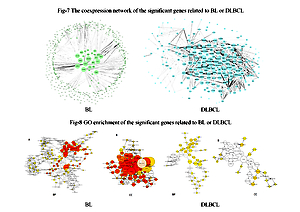Current issue
Archive
Manuscripts accepted
About the Journal
Editorial office
Editorial board
Section Editors
Abstracting and indexing
Subscription
Contact
Ethical standards and procedures
Most read articles
Instructions for authors
Article Processing Charge (APC)
Regulations of paying article processing charge (APC)
HEMATOLOGY / RESEARCH PAPER
Genomic signatures in pediatric advanced stage Burkitt lymphoma/leukemia in a Chinese population detected by next generation sequencing
1
Children’s Hospital of Chongqing Medical University, China
Submission date: 2020-09-07
Final revision date: 2020-11-27
Acceptance date: 2020-11-29
Online publication date: 2021-04-13
KEYWORDS
TOPICS
ABSTRACT
Introduction:
Burkitt lymphoma/leukemia (BL/BAL) is the most common lymphoma in children, and the sporadic subtype is dominant in Chinese populations. MYC gene translocations are essential for sporadic BL/BAL (sBL/BAL), but other gene mutations also play important roles in sBL/BAL.
Material and methods:
Clinical data of ten Chinese children with sBL/BAL were collected, next generation sequencing of tumor tissues was carried out. Cases of BL and diffuse large B cell lymphoma (DLBCL) were collected from a database, bioinformatics analysis was conducted
Results:
Nine boys and one girl were enrolled, the average age at diagnosis was 100.10±13.39m; MYC rearrangements were confirmed. The patients received combination treatment of chemotherapy and rituximab. All patients achieved complete remission and were alive without relapse. Germline causal gene mutations were detected in four (40%) patients by whole-exome sequencing; ID3, BRCA2, ARID1A and SMARCA4 mutations, in addition to MYC mutations, were the most common somatic mutations. Gene functions in etiology were different between the BL and DLBCL datasets. The identified mutated genes were enriched and connected by GO or KEGG pathways, it seemed that the PI3K-Akt signaling pathway played important roles in the etiology of sBL/BAL; the EGFR-TKI resistance pathway was also analyzed.
Conclusions:
The different gene mutations might be index to identify BL or DLBCL in case of difficult pathologic samples. Molecular hallmark of sBL/BAL is MYC translocation, whereas additional gene mutations also occur and play roles in the progression of the disease. sBL/BAL might be controlled by curbing the PI3K-Akt signaling pathway; the EGFR-TKI treatment might not be helpful in sBL/BAL.
Burkitt lymphoma/leukemia (BL/BAL) is the most common lymphoma in children, and the sporadic subtype is dominant in Chinese populations. MYC gene translocations are essential for sporadic BL/BAL (sBL/BAL), but other gene mutations also play important roles in sBL/BAL.
Material and methods:
Clinical data of ten Chinese children with sBL/BAL were collected, next generation sequencing of tumor tissues was carried out. Cases of BL and diffuse large B cell lymphoma (DLBCL) were collected from a database, bioinformatics analysis was conducted
Results:
Nine boys and one girl were enrolled, the average age at diagnosis was 100.10±13.39m; MYC rearrangements were confirmed. The patients received combination treatment of chemotherapy and rituximab. All patients achieved complete remission and were alive without relapse. Germline causal gene mutations were detected in four (40%) patients by whole-exome sequencing; ID3, BRCA2, ARID1A and SMARCA4 mutations, in addition to MYC mutations, were the most common somatic mutations. Gene functions in etiology were different between the BL and DLBCL datasets. The identified mutated genes were enriched and connected by GO or KEGG pathways, it seemed that the PI3K-Akt signaling pathway played important roles in the etiology of sBL/BAL; the EGFR-TKI resistance pathway was also analyzed.
Conclusions:
The different gene mutations might be index to identify BL or DLBCL in case of difficult pathologic samples. Molecular hallmark of sBL/BAL is MYC translocation, whereas additional gene mutations also occur and play roles in the progression of the disease. sBL/BAL might be controlled by curbing the PI3K-Akt signaling pathway; the EGFR-TKI treatment might not be helpful in sBL/BAL.
Share
RELATED ARTICLE
We process personal data collected when visiting the website. The function of obtaining information about users and their behavior is carried out by voluntarily entered information in forms and saving cookies in end devices. Data, including cookies, are used to provide services, improve the user experience and to analyze the traffic in accordance with the Privacy policy. Data are also collected and processed by Google Analytics tool (more).
You can change cookies settings in your browser. Restricted use of cookies in the browser configuration may affect some functionalities of the website.
You can change cookies settings in your browser. Restricted use of cookies in the browser configuration may affect some functionalities of the website.



